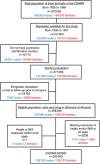Childhood body mass index in relation to future risk of oesophageal adenocarcinoma
- PMID: 25562436
- PMCID: PMC4453659
- DOI: 10.1038/bjc.2014.646
Childhood body mass index in relation to future risk of oesophageal adenocarcinoma
Abstract
Background: Middle-aged obese adults are at substantially elevated risk of oesophageal adenocarcinoma. It is unclear whether this risk originates earlier in life.
Methods: We assessed associations between childhood body mass index (BMI) and height-measured annually between ages 7 and 13-with adult oesophageal adenocarcinoma in a cohort from the Copenhagen School Health Records Register. Analyses included 255 053 children born during 1930-1971. Danish Cancer Registry linkage provided outcomes. We calculated hazard ratios (HRs) and 95% confidence intervals (CIs) using Cox proportional hazards regression.
Results: During 5.4 million person-years of follow-up, 254 (216 males) incident oesophageal adenocarcinomas occurred. At each examined age, cancer risk increased linearly per unit BMI z-score, although associations were only statistically significant for ages 9-13. The HR for the age of 13 years was 1.31 (95% CI: 1.13, 1.51) per unit BMI z-score. Associations were similar in men and women and across birth cohorts. Childhood height was not related to cancer risk in men but was in women, although these analyses included just 38 female cases. HRs per unit height z-score at the age of 13 years were 1.04 (0.90, 1.19) in males and 1.77 (1.27, 2.47) in females, with similar results observed at the other examined ages.
Conclusion: Individuals with higher childhood BMI were at elevated risk of oesophageal adenocarcinoma, even though these cancers occurred many decades later in life. Although the mechanisms require further investigation, our findings provide additional evidence for the long-term health risks of childhood obesity.
Figures


References
-
- Abdullah A, Wolfe R, Mannan H, Stoelwinder JU, Stevenson C, Peeters A. Epidemiologic merit of obese-years, the combination of degree and duration of obesity. Am J Epidemiol. 2012;176:99–107. - PubMed
-
- Abrams P, Levitt Katz LE. Metabolic effects of obesity causing disease in childhood. Curr Opin Endocrinol Diabetes Obes. 2011;18:23–27. - PubMed
-
- Adegboye AR, Andersen LB, Froberg K, Sardinha LB, Heitmann BL. Linking definition of childhood and adolescent obesity to current health outcomes. Int J Pediatr Obes. 2010;5:130–142. - PubMed
Publication types
MeSH terms
LinkOut - more resources
Full Text Sources
Other Literature Sources
Medical

